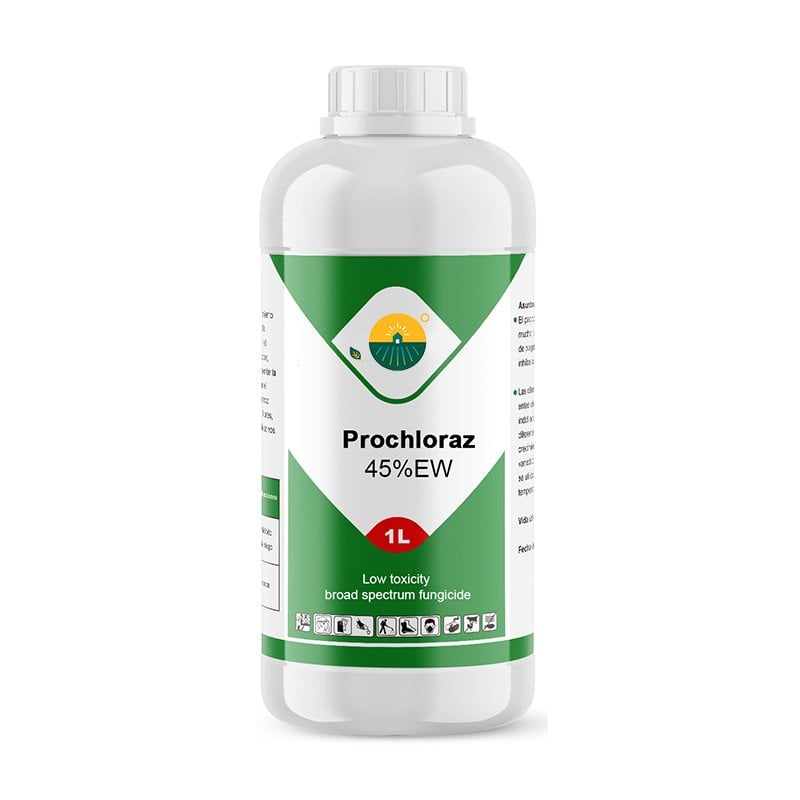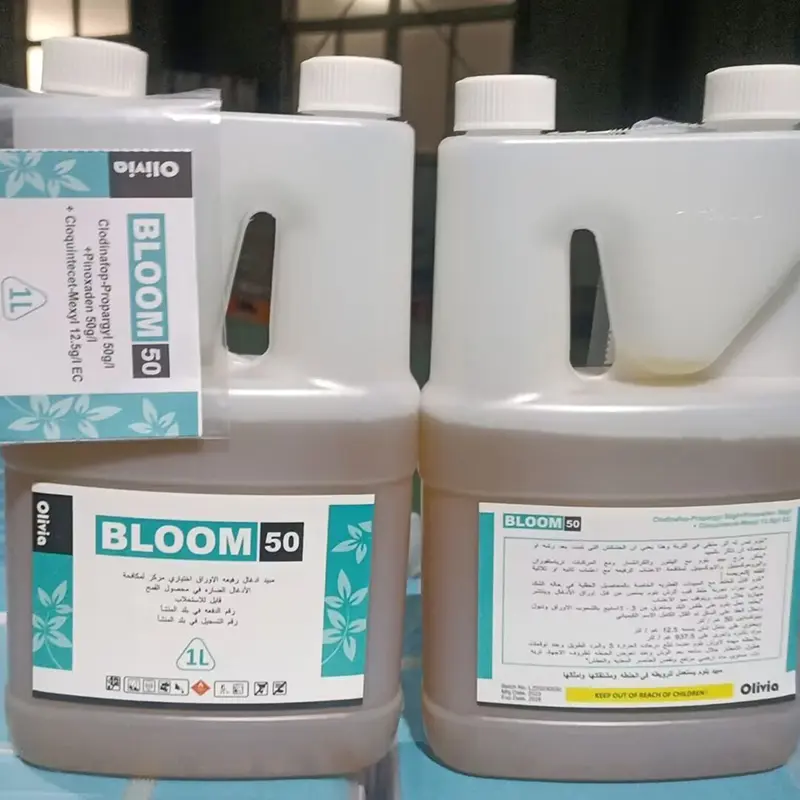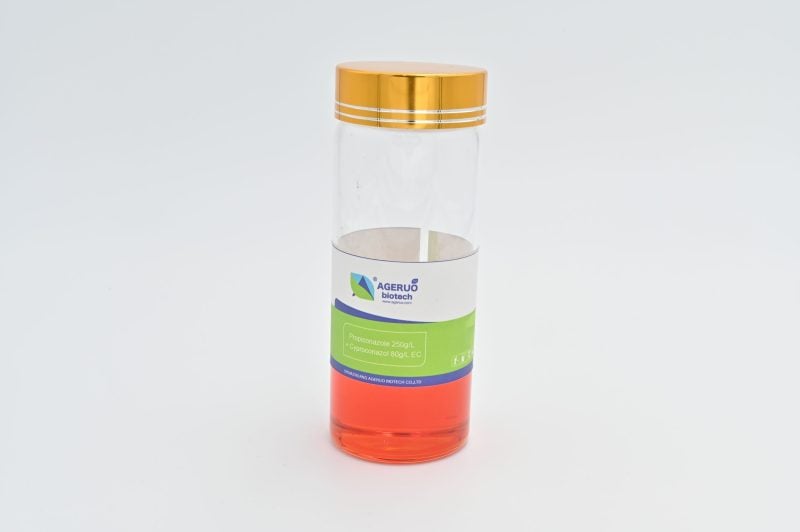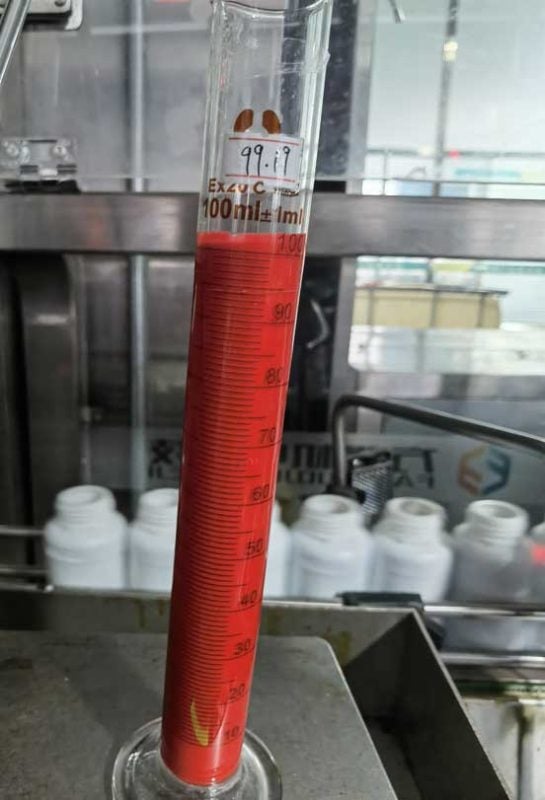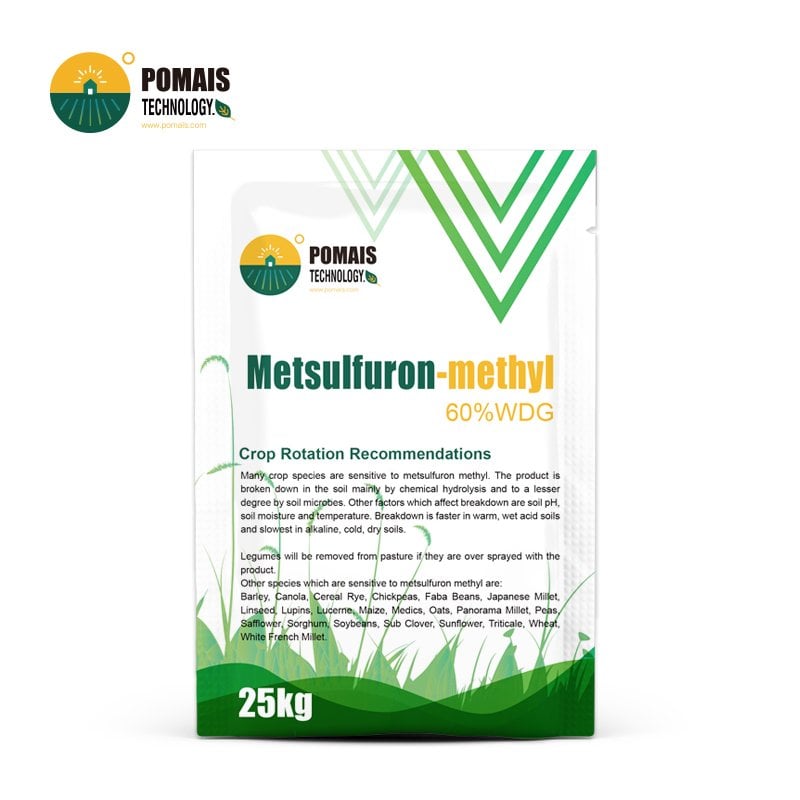Prochloraz 450g/L Fungicide
Prochloraz is a widely used imidazole fungicide with broad-spectrum activity, designed to protect a variety of crops from fungal diseases. It is effective on field crops, fruits, vegetables, and ornamental plants, and is commonly used in combination with other fungicides to enhance its efficacy.
Prochloraz can be applied to control fungal diseases in cereals, vegetables, oilseed rape, sugar beet, rice, and coffee, among other crops. Its unique formulation makes it suitable for both foliar application and seed treatment, offering versatile use in agricultural and horticultural settings.
- Designed for Professional Buyers & Bulk Orders
- This product is available for business purchase and large-scale distribution.
- We support custom packaging, labeling, and formulation to meet your market needs.
- Let’s build your brand together.

About Prochloraz 450g/L Fungicide
About Prochloraz 450g/L Fungicide
| Active Ingredient | Prochloraz |
| Formulations Available | 25% EC, 45% EC, EW, Prochloraz-Manganese Chloride Complex 60% WP, Prochloraz 267g/L + Tebuconazole 133g/L EW, Prochloraz 400g/L + Propiconazole 90g/L EC, Prochloraz 17.5% + Difenoconazole 7.5% SC |
| Target Diseases | Anthracnose, leaf spot, rust, Alternaria, powdery mildew |
| Suitable Crops | Mango, Papaya, Beans, Tomato, Cereals |
| Dosage | 70-150 ml per 200L of water |
| Application Method | Foliar spray |
| Mode of Action | Systemic fungicide; disrupts fungal cell membrane formation |
| Advantages | Broad-spectrum control, systemic action, effective in mixtures with other fungicides |
| Packaging Types | Available in various sizes |
| Application Frequency | Apply every 7-10 days, up to 2-3 times per season |
| Storage | Store in a cool, dry, well-ventilated area |
For detailed information on formulation availability, pricing, and tailored usage instructions, feel free to contact us. We are dedicated to supporting your agricultural success with high-quality, effective fungicide solutions.
Prochloraz Fungicide
Prochloraz is a highly effective fungicide that works by disrupting sterol biosynthesis in fungal pathogens, preventing the formation of cell membranes and inhibiting fungal growth. This makes it particularly useful for controlling a wide range of fungal diseases across multiple crops.
- Broad-Spectrum Fungicide: Prochloraz provides excellent control of powdery mildew, leaf spot, rust, anthracnose, and other fungal infections affecting cereals, vegetables, and fruit crops.
- Combination Use: Prochloraz can be mixed with other fungicides such as carbendazim for enhanced control, offering a synergistic effect that improves the overall efficacy of the treatment.
Formulation Availability
| Formulation Type | Details |
|---|---|
| Prochloraz 25% EC | Effective against a variety of fungal diseases in field crops |
| Prochloraz 45% EC, EW | Provides systemic and protective action |
| Prochloraz-Manganese Chloride Complex 60% WP | Offers enhanced disease control for multiple crops |
| Prochloraz 267g/L + Tebuconazole 133g/L EW | Strong combined action for controlling fungal pathogens |
| Prochloraz 400g/L + Propiconazole 90g/L EC | Widely used in cereals for controlling powdery mildew and rust |
| Prochloraz 17.5% + Difenoconazole 7.5% SC | Provides preventive and curative treatment for leaf spot diseases |
Advantages of Prochloraz
- Broad-Spectrum Disease Control:
- Prochloraz is effective in controlling a wide variety of fungal diseases, including anthracnose, leaf spot, rust, Alternaria, powdery mildew, and others. This broad-spectrum control makes it a valuable tool for farmers dealing with multiple pathogens.
- Systemic Action:
- When applied, Prochloraz is absorbed by the plant and transported throughout its tissues, offering long-lasting protection against fungal infections. This systemic action makes it effective even in parts of the plant that were not directly sprayed.
- Highly Effective in Mixtures:
- Prochloraz can be combined with other fungicides like carbendazim, tebuconazole, or propiconazole to enhance its effectiveness. This is particularly useful for crops where multiple diseases need to be managed simultaneously.
Application Guidelines
Prochloraz should be applied as a foliar spray, ensuring the plant is evenly covered. Below are the general guidelines for usage:
| Crop | Target Disease | Dosage (ml per 200L of water) | Application Method |
|---|---|---|---|
| Mango | Anthracnose | 70-150 ml | Foliar spray |
| Papaya | Leaf spot | 70-150 ml | Foliar spray |
| Beans | Rust | 70-150 ml | Foliar spray |
| Tomato | Alternaria | 70-150 ml | Foliar spray |
- Application Frequency: Apply once every 7-10 days for continued protection. The product can be used 2-3 times per growing season depending on the severity of the infestation.
- Environmental Considerations: Avoid spraying during windy conditions or if rain is expected within one hour after application.
Market Performance and Customer Feedback
Prochloraz has been exported to over 56 countries and continues to receive positive feedback from customers in regions such as Iraq, Syria, Indonesia, and Venezuela. Farmers and agricultural professionals praise its broad-spectrum effectiveness, especially in managing multiple diseases simultaneously.
Customer Testimonial: “We’ve been using Prochloraz for our crops, and the results have been impressive. It’s reliable, easy to use, and offers strong protection throughout the season.”
Safety & Environmental Precautions
User Safety
When handling and applying Prochloraz, always wear appropriate personal protective equipment (PPE) including chemical-resistant gloves, protective clothing, goggles, and masks. Avoid direct skin and eye contact. After application, thoroughly wash hands and exposed areas with soap and water, particularly before eating, drinking, or smoking. Proper hygiene practices significantly minimize potential exposure.
Environmental Impact
Prochloraz is toxic to aquatic organisms; thus, special care must be taken to prevent contamination of water bodies. Avoid application near lakes, rivers, ponds, and streams. Comply with local environmental regulations regarding product disposal and avoid drifting spray that could affect non-target organisms and sensitive habitats.
Resistance Management
To reduce the risk of fungal pathogens developing resistance to Prochloraz, follow these best practices:
- Rotation of Fungicides: Alternate Prochloraz with fungicides having different modes of action to prevent resistance buildup.
- Tank Mixing: Combine Prochloraz with compatible fungicides to enhance effectiveness and broaden the spectrum of control, reducing resistance development.
- Recommended Dosage Adherence: Always use the recommended dose and frequency. Under-dosing may not effectively control diseases, while overdosing can accelerate resistance.
Compatibility
Prochloraz can be safely mixed with most fungicides and agrochemicals. However, always conduct a small-scale compatibility test before large-scale application to confirm physical and chemical compatibility. Avoid mixing with strong acids or alkaline substances, as these can degrade the effectiveness of Prochloraz or create adverse reactions.
Re-entry Interval (REI)
To ensure safety, it is recommended to wait at least 24 hours after the application before re-entering treated areas. If early re-entry is necessary, individuals must wear adequate protective gear to minimize exposure risks.
Pre-Harvest Interval (PHI)
Maintain the following minimum intervals between the last application of Prochloraz and crop harvesting:
- Cereals: 14 days
- Fruits: 7 days
- Vegetables: 7 days
Observing these intervals helps ensure produce safety and compliance with residue limits.
Toxicological Information
Acute Toxicity
Prochloraz exhibits low acute toxicity in humans. However, direct exposure may cause irritation to skin and eyes. Proper protective measures must always be observed.
Chronic Toxicity
Long-term or high-level exposure could potentially affect liver function. Regular health checks and precautions to limit chronic exposure are advisable.
First Aid Measures
- Skin Exposure: Immediately rinse with plenty of clean water.
- Eye Contact: Flush eyes with clean water for at least 15 minutes and seek medical attention.
- Ingestion: Do NOT induce vomiting; seek immediate medical assistance.
Regulatory Status
Prochloraz is approved and registered for use in various countries around the globe for the management of fungal diseases in multiple crops. Regulatory requirements and restrictions can vary by country; therefore, users must verify compliance with local agricultural authorities and environmental agencies before use.
| Active Ingredient | Prochloraz |
| Formulations Available | 25% EC, 45% EC, EW, Prochloraz-Manganese Chloride Complex 60% WP, Prochloraz 267g/L + Tebuconazole 133g/L EW, Prochloraz 400g/L + Propiconazole 90g/L EC, Prochloraz 17.5% + Difenoconazole 7.5% SC |
| Target Diseases | Anthracnose, leaf spot, rust, Alternaria, powdery mildew |
| Suitable Crops | Mango, Papaya, Beans, Tomato, Cereals |
| Dosage | 70-150 ml per 200L of water |
| Application Method | Foliar spray |
| Mode of Action | Systemic fungicide; disrupts fungal cell membrane formation |
| Advantages | Broad-spectrum control, systemic action, effective in mixtures with other fungicides |
| Packaging Types | Available in various sizes |
| Application Frequency | Apply every 7-10 days, up to 2-3 times per season |
| Storage | Store in a cool, dry, well-ventilated area |
For detailed information on formulation availability, pricing, and tailored usage instructions, feel free to contact us. We are dedicated to supporting your agricultural success with high-quality, effective fungicide solutions.
Prochloraz Fungicide
Prochloraz is a highly effective fungicide that works by disrupting sterol biosynthesis in fungal pathogens, preventing the formation of cell membranes and inhibiting fungal growth. This makes it particularly useful for controlling a wide range of fungal diseases across multiple crops.
- Broad-Spectrum Fungicide: Prochloraz provides excellent control of powdery mildew, leaf spot, rust, anthracnose, and other fungal infections affecting cereals, vegetables, and fruit crops.
- Combination Use: Prochloraz can be mixed with other fungicides such as carbendazim for enhanced control, offering a synergistic effect that improves the overall efficacy of the treatment.
Formulation Availability
| Formulation Type | Details |
|---|---|
| Prochloraz 25% EC | Effective against a variety of fungal diseases in field crops |
| Prochloraz 45% EC, EW | Provides systemic and protective action |
| Prochloraz-Manganese Chloride Complex 60% WP | Offers enhanced disease control for multiple crops |
| Prochloraz 267g/L + Tebuconazole 133g/L EW | Strong combined action for controlling fungal pathogens |
| Prochloraz 400g/L + Propiconazole 90g/L EC | Widely used in cereals for controlling powdery mildew and rust |
| Prochloraz 17.5% + Difenoconazole 7.5% SC | Provides preventive and curative treatment for leaf spot diseases |
Advantages of Prochloraz
- Broad-Spectrum Disease Control:
- Prochloraz is effective in controlling a wide variety of fungal diseases, including anthracnose, leaf spot, rust, Alternaria, powdery mildew, and others. This broad-spectrum control makes it a valuable tool for farmers dealing with multiple pathogens.
- Systemic Action:
- When applied, Prochloraz is absorbed by the plant and transported throughout its tissues, offering long-lasting protection against fungal infections. This systemic action makes it effective even in parts of the plant that were not directly sprayed.
- Highly Effective in Mixtures:
- Prochloraz can be combined with other fungicides like carbendazim, tebuconazole, or propiconazole to enhance its effectiveness. This is particularly useful for crops where multiple diseases need to be managed simultaneously.
Application Guidelines
Prochloraz should be applied as a foliar spray, ensuring the plant is evenly covered. Below are the general guidelines for usage:
| Crop | Target Disease | Dosage (ml per 200L of water) | Application Method |
|---|---|---|---|
| Mango | Anthracnose | 70-150 ml | Foliar spray |
| Papaya | Leaf spot | 70-150 ml | Foliar spray |
| Beans | Rust | 70-150 ml | Foliar spray |
| Tomato | Alternaria | 70-150 ml | Foliar spray |
- Application Frequency: Apply once every 7-10 days for continued protection. The product can be used 2-3 times per growing season depending on the severity of the infestation.
- Environmental Considerations: Avoid spraying during windy conditions or if rain is expected within one hour after application.
Market Performance and Customer Feedback
Prochloraz has been exported to over 56 countries and continues to receive positive feedback from customers in regions such as Iraq, Syria, Indonesia, and Venezuela. Farmers and agricultural professionals praise its broad-spectrum effectiveness, especially in managing multiple diseases simultaneously.
Customer Testimonial: “We’ve been using Prochloraz for our crops, and the results have been impressive. It’s reliable, easy to use, and offers strong protection throughout the season.”
Safety & Environmental Precautions
User Safety
When handling and applying Prochloraz, always wear appropriate personal protective equipment (PPE) including chemical-resistant gloves, protective clothing, goggles, and masks. Avoid direct skin and eye contact. After application, thoroughly wash hands and exposed areas with soap and water, particularly before eating, drinking, or smoking. Proper hygiene practices significantly minimize potential exposure.
Environmental Impact
Prochloraz is toxic to aquatic organisms; thus, special care must be taken to prevent contamination of water bodies. Avoid application near lakes, rivers, ponds, and streams. Comply with local environmental regulations regarding product disposal and avoid drifting spray that could affect non-target organisms and sensitive habitats.
Resistance Management
To reduce the risk of fungal pathogens developing resistance to Prochloraz, follow these best practices:
- Rotation of Fungicides: Alternate Prochloraz with fungicides having different modes of action to prevent resistance buildup.
- Tank Mixing: Combine Prochloraz with compatible fungicides to enhance effectiveness and broaden the spectrum of control, reducing resistance development.
- Recommended Dosage Adherence: Always use the recommended dose and frequency. Under-dosing may not effectively control diseases, while overdosing can accelerate resistance.
Compatibility
Prochloraz can be safely mixed with most fungicides and agrochemicals. However, always conduct a small-scale compatibility test before large-scale application to confirm physical and chemical compatibility. Avoid mixing with strong acids or alkaline substances, as these can degrade the effectiveness of Prochloraz or create adverse reactions.
Re-entry Interval (REI)
To ensure safety, it is recommended to wait at least 24 hours after the application before re-entering treated areas. If early re-entry is necessary, individuals must wear adequate protective gear to minimize exposure risks.
Pre-Harvest Interval (PHI)
Maintain the following minimum intervals between the last application of Prochloraz and crop harvesting:
- Cereals: 14 days
- Fruits: 7 days
- Vegetables: 7 days
Observing these intervals helps ensure produce safety and compliance with residue limits.
Toxicological Information
Acute Toxicity
Prochloraz exhibits low acute toxicity in humans. However, direct exposure may cause irritation to skin and eyes. Proper protective measures must always be observed.
Chronic Toxicity
Long-term or high-level exposure could potentially affect liver function. Regular health checks and precautions to limit chronic exposure are advisable.
First Aid Measures
- Skin Exposure: Immediately rinse with plenty of clean water.
- Eye Contact: Flush eyes with clean water for at least 15 minutes and seek medical attention.
- Ingestion: Do NOT induce vomiting; seek immediate medical assistance.
Regulatory Status
Prochloraz is approved and registered for use in various countries around the globe for the management of fungal diseases in multiple crops. Regulatory requirements and restrictions can vary by country; therefore, users must verify compliance with local agricultural authorities and environmental agencies before use.
Related Products
Latest News

